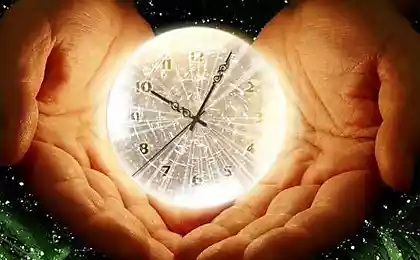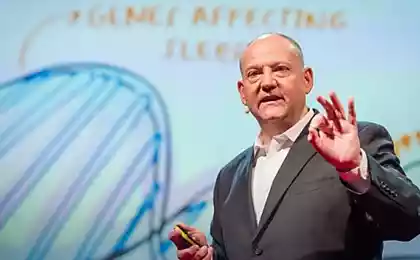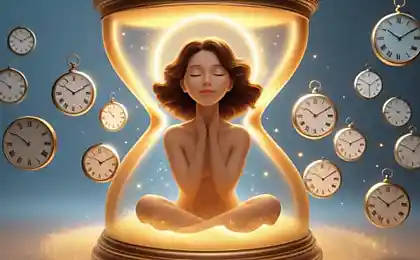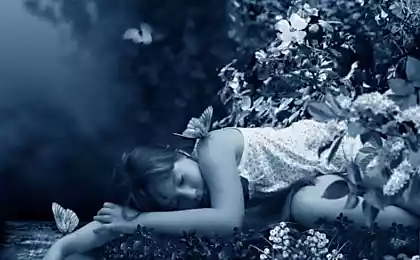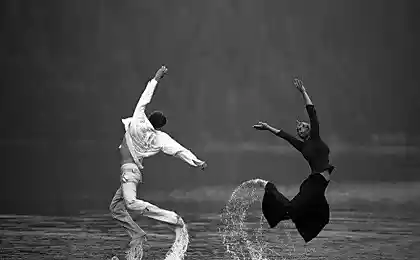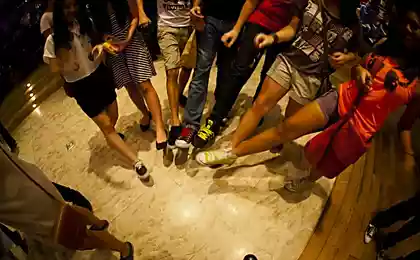639
Interrupted sleep: why midnight is the best time for creativity

© Michael Lewis
Long ago, our ancestors woke up in the middle of the night to reflect, record your ideas or to make love. In the silence and darkness of midnight they entered a special state due to physiological changes in the body, fell in the twilight zone between sleep and wakefulness. What we've been missing, when they began to sleep through the night? T&P have translated an article by the Scottish writer, artist and photographer Karen Emsley, published in the journal Aeon.

Patent incandescent lamp of Thomas Edison, 1879. Photo from the National archives
4.18 in the morning. In the fireplace burn down to orange coals, gradually turning to ash. The constellation Orion hanging over the hill. Taurus hung overhead in the form of a shiny V that points to the Pleiades. Sirius, the faithful dog of Orion, a pulsing red-blue-purple like intergalactic discolor.
Now 4.18 am, I'm awake. At such an early awakening often see the symptom of depression or anxiety disorder, a failure of the natural rhythm of the body. At 4 in the morning I do Wake up with a buzzing head. And although I am happy with my life in the dark fills me with anxiety. For me, it is better to get out of bed than to teeter on the brink of lunatic madness.
When I write in the wee hours, dark thoughts become clear and colorful. They are expressed in words and sentences, clinging to one another, as if following each other elephants. My brain works differently at night; I can only write and can't edit. I can only add, and you can't get rid of anything. For accuracy I need a clear day judgment.
All the people, animals, insects and birds have an internal clock, a biological device, controlled by genes, proteins and molecular chains. These internal clocks associated with continuous light cycle, caused by rotation and tilt of our planet. These properties govern the primal physiological, neural and behavioural systems of the body in accordance with a 24-hour cycle, also known as the circadian rhythm, affecting our mood, appetite, sleep and sense of time.
Industrial society, based on the clock time entered the world of concepts such as urgency, punctuality or a waste of time.
The Romans, Greeks and Incas woke up without the aid of alarms in their iPhones or radios. Nature was their chronometer: sunrise, morning singing, untilled fields, and the hungry animals. Time was counted solar and hourglass, while in the XIV century churches and monasteries began to build mechanical clocks. By the early nineteenth century, chronometers were worn on neck chains, her wrists and lapels — now you can make appointments and set time for meals and sleep. Industrial society, based on the clock time entered the world of concepts such as urgency, punctuality or a waste of time. The time on the clock is increasingly out of sync with natural time, although light and darkness are still determined our working day and social structure.
In the late nineteenth century, everything changed.
The lights came on.
Modern electrical illumination revolutionised the night and, in turn, sleep. According to the historian Roger Ekirch, to Edison's time a night's sleep divided into two parts, separated by a period of wakefulness, which could last several hours. This mode is called polyphasic sleep. Sleep patterns of the past can surprise us. You may think that in accordance with your circadian rhythm, we would have to Wake up at dawn. But Ekirch believes that if the people returned to their natural pace, they would have slept in several intervals — as many animals and insects. His arguments are based on 16 years of research during which he examined hundreds of historical documents from ancient times to the present, including diaries, court records, medical books and literature. He found many references to "first" and "second" sleep in English. In other languages, this separation is also mentioned: there are, for example, "premier sommeil" in French, "primo sonno" in Italian and "primo somno" in Latin. It is the ordinariness of these allusions to polyphasic sleep let Akiru to conclude that this pattern was once common, the daily cycle of sleep and wakefulness.
Before the advent of electric lighting, night was associated with crime and fear — people stayed home and went to bed early. The time of their "first" sleep depended on the time of year and social status, but most often it came in a couple of hours after sunset and lasted three to four hours, after which the sleepers naturally Wake in the night. Before the advent of electric light wealthy family often used other forms of artificial light — for instance, gas lamps — and, accordingly, went to bed late. Interestingly, in the personal papers of these families there was less mention of polyphasic sleep.
During the night waking people read, prayed, wrote, solved their dreams, talking to his partners and made love. Ekirch notes that after a hard day's people often were too tired for lovemaking (that can be in tune with the feelings of many modern people), but the middle of the night waking refreshed, our ancestors were ready for business. Podela a variety of things, people were tired and again immersed in a dream — in the second phase (also for three or four hours) before rising to meet the new day.

Ekirch found that the mention of these two phases of sleep almost completely disappeared by the beginning of XX century. Electricity has significantly increased the amount of lighting and the afternoon sessions now lasted and at night; illuminated streets became safer, it became fashionable to communicate outside the home. Time bedtime was late, and night-waking, incompatible with an extended day, was squeezed out. But Ekirch believes that we lost not only the time, but its special properties. Vigil, he told me, was perfect by nature from the day's waking life, at least according to found documents. The third United States President Thomas Jefferson, for example, read books on the philosophy of morality before sleep, then to think about them after their "first" sleep. English poet of the seventeenth century, Francis Quarls appreciated the darkness as well as silence, as an aid to internal reflection:
"Let the end of thy first sleep to awaken you from your rest, then your body the best temper, then your soul the least burden; then no noise that bothered my ear; no object then that would distract your eye out."
My personal experience confirms this difference; in the night my brain is in the power of dreams. During sleep, our memory, our desires and our fears give rise to many images. The slumbering mind of the debris of a dream brings to life new ideas and use them during art. In the essay "Sleep We Have Lost" Ekirch writes that, most likely, before the moment of awakening from the "first" dream, people were still completely in the power of dreams "and thus their dreams could be absorbed before returning to the unconscious. People were relaxed with the exception of those cases when they were distracted by noise, sickness or some other inconvenience".
Ideas Akira about polyphasic sleep obtained from old documents and archives, but confirmed by modern researches. Psychiatrist Thomas Wehr of the U.S. national Institute of mental health found that polyphasic sleep is back with the disappearance of artificial lighting. During the experiment, held during the month, in 1990, the experiment subjects had access to light for 10 hours — in contrast to the artificially increased 16-hour period, which is now the norm. Within this natural cycle, Wehr says, "sleep time was increased and was usually divided into two symmetrical cut lasting several hours, with an interval of wakefulness lasting from one to three hours."
Due to the collision between the natural mode of sleep and our rigid social structures — clock time, industrialisation, school schedule, work schedule, we think that polyphasic sleep is a disorder
And research Akira, and the work of Faith still influence the study of sleep. Ideas Akira was specifically discussed at the annual meeting of the Association of American professional sleep society in 2013. One of the most important insights was that the most common "midnight" insomnia is not a disorder, but rather a return to the natural form of sleep — a shift in perception that greatly reduced my own concern about my night vigils.
Now 7.04 in the morning. I wrote for about three hours and now are going to go to bed for my "second" sleep. I will take up again the work day. Chosen way of living (no kids, work for myself) allows me this. But I had to adapt to working 9 to 5, and a working schedule almost incompatible with the usual sleep mode; for a person robotstudio a few hours of the night and just lying to sleep, nothing is as bad as to hear the alarm bells. Because of the collision between the natural mode of sleep and our rigid social structures — clock time, industrialisation, school schedule, work schedule, we think that polyphasic sleep is a disorder, not an advantage.
Creative people often find an opportunity to live by rigid routine: or because they are quite successful in his creative endeavors and don't need another job, or because they are trying to work flexible hours — for example, freelancing.
The "Daily Rituals: How Artists Work," Mason Curry describes the routines of famous writers and artists, many of which were larks, some were supporters of the polyphasic sleep. Curry found that many have stumbled on this method accidentally sleep. Architect Frank Lloyd Wright, for example, woke up at four a.m. and couldn't sleep, so he worked for three to four hours and then back asleep. Nobel laureate Knut Hamsun often woke up after a couple hours of sleep. So he kept a pen and paper near the bed and, in his own words, immediately began to write in the dark if felt that he finds inspiration. Psychologist Burrus Frederic Skinner kept the tablet, paper and pencil near the bed to work during periods of night wakefulness, and the writer Marilyn Robinson commonly woke up to read or to pee during what she called his "benevolent insomnia".
Some of us are morning people, others night people. Larks or owls. Curry argues that creative people who work in the night, "using their optimum condition, they need to work" and which are driven by the natural biorhythms rather than a personal choice.
Novelist Nicholson Baker was the only person of those who met Curry, who consciously began to practice polyphasic sleep. Baker knows his writing habits and your routines and likes to experiment with the rituals when writing each new book, told me Curry. It seems appropriate that he snatched a couple of extra productive hours, vykraivaya for two "in the morning" in one day. Indeed, when Baker was writing what later became the novel "A Box of Matches" — a story about a writer who wakes up at 4 a.m., turns on the light and wrote, while his family sleeps, he practiced the same ritual, then went to their "second" sleep. "I found that the lighting of this tiny flame helps me focus," said Baker journalist of The Paris Review. "There's something simple and pleasantly meditative in kindling flame at 4 am. I started to write some passages, and I was given a very easy".

It seems that this smoothness characterizes the creative work begun in the middle of the night. At this moment there are no distractions, in the silence of our connection with dreams is enhanced. With the coming of night in our brain are triggered hormonal processes that contribute to creativity. Wehr said that during the night waking, the pituitary gland produces a large amount of prolactin. This hormone is associated with the sense of peace and is responsible for the occurrence of hallucinations, which we can see while falling asleep or awakening. He excels at sexual satisfaction, at the time of lactation of nursing mothers, and it causes hens to hatch eggs for a long time. It changes our mental condition.
It is known that the level of prolactin increases during sleep, but Wehr found that (along with melatonin and cortisol) it continues to rise and during the so-called "quiet revival" between the phases of sleep caused by natural light cycles and not associated with sleep as such. Pumped prolactin, blazhenstvuya brain gives our ideas the opportunity to appear and weave as if in a dream.
If the industrial revolution flooded us with light, the digital revolution may prove to be much more sympathetic towards polyphasic sleep
Ver suggests that the current schedule is not changed only our sleep, but also deprived us of the ancient connection between our dreams and waking life, and even "can serve as a physiological explanation for the observation that modern humans have lost touch with the life-giving source of myths and fantasies". Ekirch agrees: "Turning night into day, modern technology has blocked the oldest path to the human soul, transforming us, using the words of English dramatist of the seventeenth century, Thomas Middleton, "in obkatannyh, deceit deprived of our dreams and fantasies."
Modern technology could disrupt our connection with dreams, and to encourage the installation procedures are not consistent with our natural rhythms, but they can also lead us back to harmony. If the industrial revolution flooded us with light, the digital revolution may prove to be much more sympathetic towards polyphasic sleep.
Technology to nourish the invention of new ways of organizing our time. Remote work, freelancing and Flexi-time are increasingly common, as well as concepts like digital nomad or a remote worker. And those who are awake at night, unable to find a harmonious balance between polyphasic sleep and work obligations, adopting a less rigid schedule. If we can find the time in order to Wake up at night and ponder our brains lubricated with prolactin, we can restore our connection with creative activity and fantasies, was enjoyed by our first parents, when, according to Akira, they "awoke from his first sleep and was thinking about the kaleidoscope of partially crystallized images, slightly blurred but otherwise vivid paintings born of their dreams".
Source: theoryandpractice.ru
Alexander Myasnikov almost all the advertised medicines useless
Rare and beautiful natural phenomenon — a thick fog in the Grand Canyon

